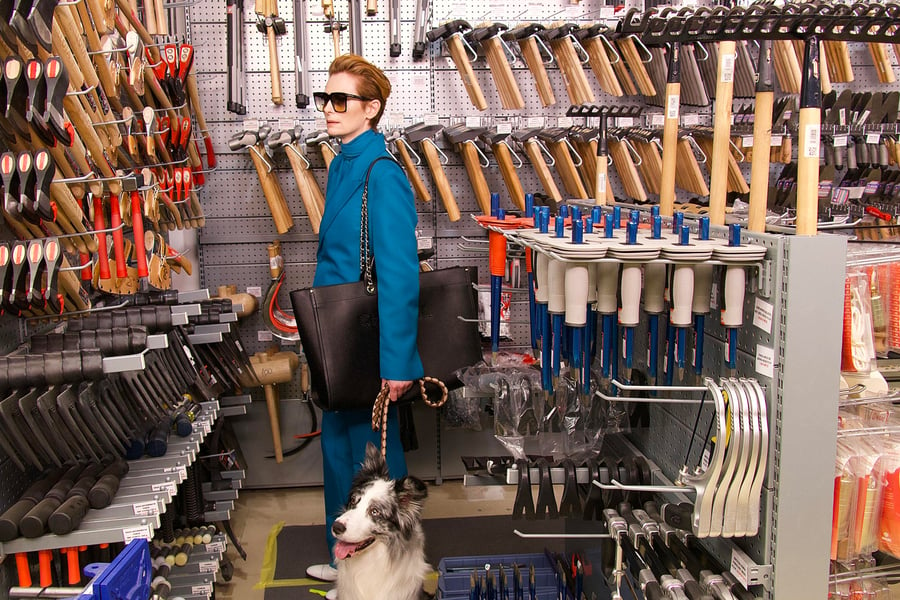There she is, stepping out from behind a screen and seen in glorious close-up: the vibrant red dress, the half-shadowed face, the untamed tangle of ginger hair. (We Stan an icon.) For the next half-hour, you’ll see Tilda Swinton’s spurned woman — she is merely referred to as “Woman” — shop for axes at a hardware store in Madrid, attack an empty suit on a bed, try on several gorgeous outfits, beg and plead for a lover’s return over the phone, hang out with a dog named Dash and set an exquisitely decorated apartment on fire. Or maybe you will watch her do all of this for the next 90 minutes if, like me, you end up watching this three times back to back.
The Human Voice is many things. It is an adaptation of a Jean Cocteau play first performed in 1930, designed as a monologue of a person gone mad with grief. It is a showcase for the 60-year-old actor, a highlight in a career that includes winning an Oscar, doing two movies with Bong Joon-Ho and transforming into David Bowie. It is her first project with Spanish filmmaker Pedro Almodóvar, and if there is a God in heaven, not her last. It is a lush short film and an exercise in extreme formalism that leaves you with the sensation you’ve just sat through a perfume commercial run amuck. And, even though it retains the basic theatrical conceit of a lone character having a one-sided conversation, it is pure cinema, because how could Almodóvar and Swinton do anything but turn this into pure cinema?
Shot during the pandemic in July, premiered at the Venice International Film Festival in August, quietly waltzed through the virtual-cinema circuit earlier this year and available to see on HBO Max as of April 30th, Voice is the culmination of the legendary moviemaker’s long obsession with Cocteau’s snippet of a stage work. He’s paid homage to the play in several of his films, notably Women on the Verge of a Nervous Breakdown, which — in a beautiful example of self-referential feedback looping, is itself given hat-tips in several spots here. But this also doubles as a guided tour of the Almodóvar’s artistic memory banks, complete with cine-fetishes and footnotes and a signature elegance-meets-extravagance aesthetic. His holy trinity of Hitchcock, Sirk and Wilder can be detected in the shifting tones, as well a faint odor of camp fumes. So much depends on upon a red pantsuit, paired with leopard-skin stilettos beside a green bedspread…and for good measure, Artemisia Gentileschi’s “Venus and Cupid” feature prominently in the background.
Great attention is paid to a table full of DVDs and books, a stocked medicine cabinet, a meticulously organized kitchen drawer. Every random item and its placement feels like a clue. (Eat your heart out, Wes Anderson.) The decor-porn vibe is offset only by the fact that it’s clearly a set, its naked bones exposed by an overhead shot, constructed on a soundstage that Swinton swishes in and out of at will. And while the texture of this short would be unthinkable without José Luis Alcaine’s cinematography, María Clara Notari’s art direction, Antxón Gómez’s production design, Vincent Diaz’s set design, Sonia Grande’s costumes and the mere existence of Cristóbal Balenciaga, this is a work that feels sprung from one creator’s skull. Coming off the semiautobiographical masterpiece 2019 Pain and Glory, Pedro has kept that film’s personal aspects but upped the playfulness you associate with his run of 1980s movies.
As for Swinton, the high priestess of auteuristic collaborativeness (a partial roll call includes not just the aforementioned Anderson and Bong but Derek Jarman, Joanna Hogg, Joel and Ethan Coen, Jim Jarmusch, Lynne Ramsay and Luca Guadagnino; next up is Apichatapong Weerasethakul) fits into her creative partner’s vision like a hand in a Gucci glove. She shares his love of grand gestures and melodrama, and a penchant for high style and archness (her character, an actor, speaks of how casting agents “love my pallor…my mixture of melancholy and madness”). What is surprising is that Almodóvar has taken a star now associated with an almost alien sense of otherwordliness — of sheer cosmic Tildaness — and brought her back to Earth. His reputation for bringing the best out of female performers and his use of close-ups precede him, but there are moments where he simply trains his camera on Swinton’s partially profiled mug and you feel you’re only really seeing her for the first time. Sometimes, all you need is the human voice and the human face to crack open a piece of art.
And, if this short is to be believed, a very human sense of hope: For a chamber piece that plays out more or less in a single apartment, it’s not a coincidence that it ends with the sight of someone walking through an open door and toward the outside world. In a mere half hour, this dynamic duo has given you an experience leagues richer than a full season of features. That you can now segue from, say, Mortal Kombat directly into this suggests that yes, nature may indeed be healing. It’s the most rewarding 30 minutes you may have all year.
From Rolling Stone US




































